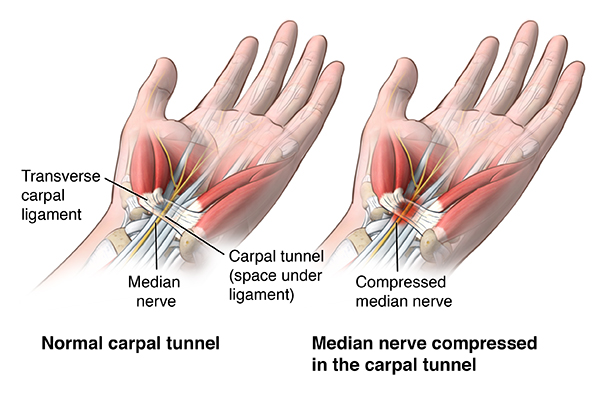There are eight small bones called carpal bones in the wrist. A ligament (also called retinaculum) lies across the front of the wrist. Between this ligament and the carpal bones is a space called the carpal tunnel. The tendons that attach the forearm muscles to the fingers pass through the carpal tunnel. The main nerve (median nerve) to the hand also goes through this tunnel before dividing into smaller branches in the palm. When this nerve is compressed, it gives symptoms of carpal tunnel syndrome.
Signs and symptoms:
- Pins and needles. This is typically the first symptom to develop. The index and middle fingers are usually the first to be affected.
- Pain. Beginning in the fingers, the pain may travel up the forearm and even to the shoulder.
- Numbness of the finger, or in part of the palm.
- Dryness of the skin.
- Weakness of some muscles in the fingers and/or thumb occurs in severe cases. This may cause poor grip and eventually lead to muscle wasting at the base of the thumb.
Symptoms tend to come and go at first, often after you use the hand. Typically, symptoms are worse at night and may wake you up. The symptoms may be eased for a while by raising the hand up or hanging it down.
When to see a doctor?
See your doctor if you have signs and symptoms of carpal tunnel syndrome that interfere with your normal activities and sleep patterns. Permanent nerve and muscle damage can occur without treatment.
کارپل ٹنل سنڈروم:
کلائی میں آٹھ چھوٹی ہڈیاں ہیں جنہیں کارپل ہڈی کہتے ہیں۔ ایک بینڈ (جسے ریٹیناکولم بھی کہا جاتا ہے)ان ہڈیوں کے اوپر کلائی کے اگلے حصے میں واقع ہوتا ہے۔ اس بینڈ اور کارپل ہڈیوں کے درمیان ایک جگہ ہے جسے کارپل ٹنل کہتے ہیں۔ اس ٹنل سے کچھ اہم پٹھے اور رگیں گزرتی ہیں۔ چھوٹی شاخوں میں تقسیم ہونے سے پہلے ہاتھ کا ایک اہم اعصاب (median nerve) بھی اس سرنگ سے گزرتا ہے۔ جب یہ اعصاب کارپل ٹنل میں دب جاتا ہے تو یہ کارپل ٹنل سنڈروم کی علامات ظاہر کرتا ہے۔
نشانات و علامات:
- سوئیاں چبھنا۔ یہ عام طور پر اس سنڈروم کی پہلی علامت ہے۔ شہادت کی اور بیچ کی انگلیاں عام طور پر سب سے پہلے متاثر ہوتی ہیں۔
- درد۔ انگلیوں سے شروع ہو کر ، درد بازو تک اور کندھے تک بھی جا سکتا ہے۔
- انگلی کی یا ہتھیلی کے کچھ حصے میں حساسیت متاثر ہوتی ہے۔
- جلد کی خشکی۔
- شدید علامتوں میں انگلیوں یا انگوٹھے میں کچھ پٹھوں کی کمزوری شامل ہے۔ یہ کمزور گرفت کا سبب بن سکتا ہے اور بالآخر انگوٹھے کے پٹھوں کو ضائع ہونے کا باعث بن سکتا ہے۔
علامات ہلکی یا تیز ہوتی رہتی ہیں ، اکثر ہاتھ کو زیادہ استعمال کرنے کے بعد تکلیف بڑھ جاتی ہے۔ عام طور پر ، علامات رات کے وقت شدت اختیار کرتی ہیں اور آپ کو نیند سے بھی بیدار کر سکتی ہیں۔ ہاتھوں کو اوپر اٹھا کر یا نیچے لٹکا کر تکلیف کو کچھ دیر کے لیے کم کیا جا سکتا ہے۔
ڈاکٹر سے کب ملنا ہے:
اگر آپ کو کارپل ٹنل سنڈروم کی علامات ہیں جو آپ کی معمول کی سرگرمیوں اور نیند میں مداخلت کرتی ہیں تو اپنے ڈاکٹر سے ملیں۔ بغیر علاج کےمستقل اعصاب اور پٹھوں کا نقصان ہوسکتا ہے۔
Doctors to consult (Neurologist):
Dr Gulab Shah Kakar, Dr Samad Panezai, Dr Saeed shaikh
Note: Click the Doctor's name to make an appointment.
Reference:
https://www.mayoclinic.org/diseases-conditions/carpal-tunnel-syndrome/symptoms-causes/syc-20355603
https://www.ninds.nih.gov/Disorders/Patient-Caregiver-Education/Fact-Sheets/Carpal-Tunnel-Syndrome-Fact-Sheet

